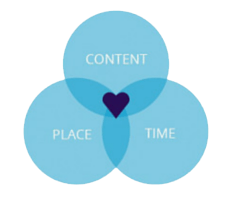In the ‘Our Story’ portion of their home page, HubSpot founders Brian Halligan and Dharmesh Shah discuss the epiphanic moment when they realized how powerful inbound marketing could become: “Inbound is about pulling people in by sharing relevant information, creating useful content, and generally being helpful. The response was overwhelmingly positive and incredibly exciting. Inbound was an idea whose time had come.”
What was so revelatory about this idea? Well, let’s recall that today’s consumers have more control over the flow of information than ever before. As a result, they have less and less patience for old-school, “outbound” marketing methodologies. These are the tactics we’ve all come to know and loathe: the cold-calls during dinner hours, pushy salespeople obscuring facts until a credit card number is doled out, etc.
Halligan and Shah didn’t just see the fallacy in these strategies on the basis of morality, but also on the basis of profitability. As consumers spend more and more time online, their interactions with brands and media are more widely varied than ever before. If a customer’s experience with a particular company’s website or blog isn’t rewarding, they have no reason to ever go back, and even less reason to interact with their brand or become a customer in the physical realm.
So, Brian and Dharmesh asked, how to keep customers intrigued by your brand in a media landscape where they aren’t forced to engage (like they are, say, when your television spot is playing and they have to sit through it before they can get back to their favorite show)?
Be Relevant.
Providing relevant content for your audience is now the proverbial name of the game. Instead of hoping that your audiences adapt to your product, inbound methodology teaches us that, as marketers, we must adapt our content to suit their desires.
So, what does it mean to create content that is truly relevant?
Well, think about what your audience is actually trying to get out of their interaction with your brand. Likely, they are aware of the line of business you are in by the time they arrive at your website/blog/etc. So obviously there’s some obligation to relevance on your own end – i.e. if you are a pizzeria it doesn’t make that much sense to have a blog posts about 401k’s, even much of your customer base is interested in such things.
Also, though, there is an important opportunity to demonstrate value by not limiting yourself to blog posts specifically about your product. Stretch out a little bit. The ideal is to provide content that is related to your field, and can demonstrate that your company represents expertise in said field, but that also isn’t just another way for you to peddle your product. As Halligan says in the co-creators’ book, Inbound Marketing: Get Found Using Google, Social Media, and Blogs, “Anything that pertains to your industry and that will be of interest to your readers: how-to articles, analysis of a current industry trend or challenge, announcements of upcoming events, feedback on articles you read in print publications, etc.”
An oft discussed example of a business owner executing this ideology successfully is Marcus Sheridan, a former pool builder and salesman who has become one of the leading figures in the world of inbound marketing. Though not a technologically gifted person by nature, Sheridan was an early adopter of blog-based inbound marketing. As a result, he saw his pool company’s revenues soar along with his celebrity (in the marketing world, anyway).
His company’s success was directly tied to the success of his blog. The posts he wrote were not just based on his own products, they were designed to make the blog a helpful, educational resource in the field of pool construction and maintenance. A cool example of this is when he posted a blog about the top swimming pool builders in his service area. One notable exclusion from his list: his own company. In his words, “the moment I put my name up there I would lose all my credibility… You vet all my competitors, now I’m showing up for all their key words. If you really want to understand the power of inbound marketing, it comes down to this idea: I want to have the conversation at my house.”
Having the conversation at your “house” means adapting to the increased control of information enjoyed by consumers in the digital age. Now that the people you are marketing to have every right and ability to quickly stop engaging, it’s your responsibility to make that engagement worthwhile for them. The more successfully you accomplish this, the more you will be able to get out of your content marketing.
Measuring Relevance
Relevance should be a major part of your mindset not only when creating content, but when measuring the success of said content. As you post blogs and cultivate a social media presence, you’ll need to make sure that the audience reaction confirms relevance and value. It is tempting to rely merely on surface level measurements (or vanity metrics), such as page views and social media ‘likes’, but it is important to avoid that pitfall.
Google Analytics can be a major ally in this regard. You can use it, along with plug-ins for it such as Scroll Depth and Riveted, to confirm not just that your audience is engaging, but that this engagement is rich in a way that will make them feel comfortable returning as a customer.
Additionally, it’s vital to monitor the conversation surrounding the topics in your field that you post about. For this, utilize tools like TweetDeck and Hootsuite. This will enable you to see how people are discussing the issues that impact your industry and guide you towards writing content that is relevant and helpful for them. This isn’t a sales pitch: if it’s going to work, it has to be genuine.
Recap
Inbound marketing is built on the foundation of positioning your brand as a valuable, educational resource, not just a sales pitch. It’s an exciting new opportunity to engage with your customers, and provides a perfect template for measuring how strong that engagement is and where it can be improved. Using the tools of the inbound methodology, combined with a desire and plan to generate genuinely valuable content will keep your customers satisfied and your profitability growing.




